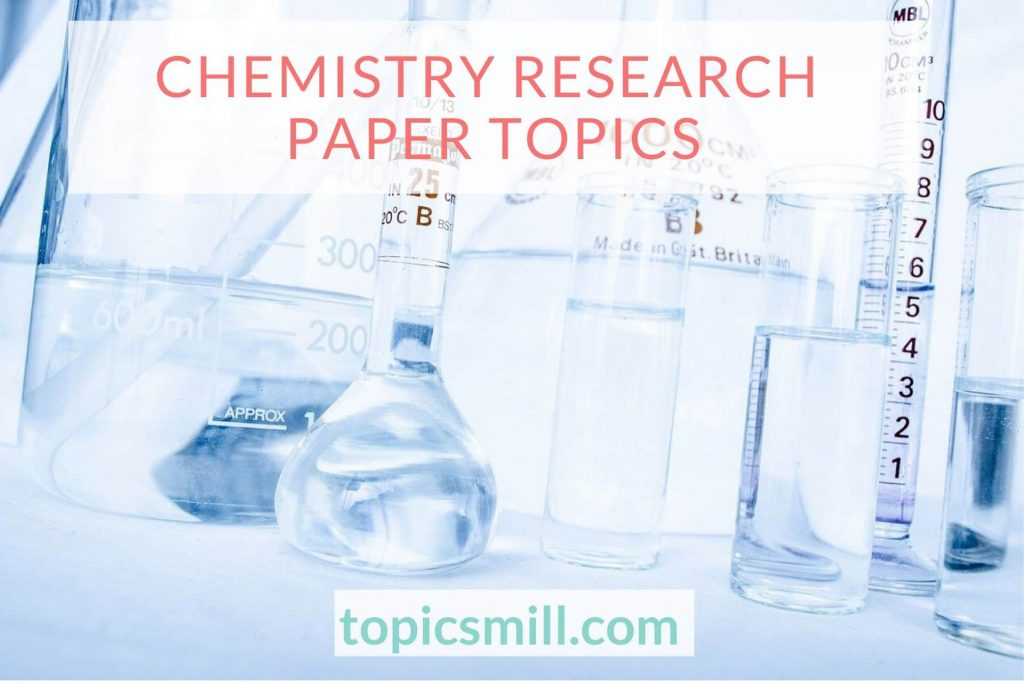Chemistry Research Paper Topics

The list of our chemistry research paper topics is designed so the students can choose an interesting topic that will make them investigate further about chemistry as a science! To write about the Chemistry of Photons, the students have to get familiar with the chemistry research paper topics before they can produce a high-quality paper! The effects of pesticides and fertilizers, the physical chemistry or metals oxides in electronics help you to understand better the materials and scientific principles that are related to the metals. The academic writings involve a lot of experiments, and these topics encourage the students to investigate the effects and interactions between elements!
Therefore, the chemistry research paper topics are designed in the perfect way, so the student learns the single concept, whether it is related to the chemicals, nutrition, the organic structure of tissues, or the synthetically made chemicals. The relation between the thermoelectricity and materials is another topic that can bring you a lot of information on chemistry, as well as its basic principles and rules. The students can find a lot of topic information and get most of the information for their paper from the Internet as well!
List of 97 Chemistry Research Paper Topics
- A look at surface tension and its implications for the future of transportation
- A look at the use of hydrogen in discovering the presence of oxygen
- ACS Applied Materials and Interfaces
- Advanced Use of Hydrogen
- Adverse Outcome Pathways
- Alcohol Poisoning and Fetal Alcohol Syndrome
- Aldehydes and Ketones as Flavoring Agents
- Allergy: What Chemistry Behind It?
- Analysis of Residues in Food
- Applications to Solar Energy Conversion or Electrocatalysis
- Artificial Organic Tissues
- Atmospheric physical chemistry
- Battery science and technology
- Behavioral Research in Biochemistry
- Beryllium and its ability to ameliorate the strengths of other metals to which it is added
- Beryllium and Its Effect on Metals
- Biocomputing and Big Data in Chemical Research
- Bioconjugates in Chemical Biology
- Biological and Synthetic Worlds
- Biological Chemistry of Sulfur and Selenium
- Bioluminescence
- Bonding of Fluorine and Inert Gases
- Catalysis and Catalytic Materials
- Characterization of Biological Systems
- Chemical neuroscience and behaviour
- Chemical Process Intensification
- Chemical Speciation of Heavy Metal Ion Using Supported Liquid Membranes
- Chemical Toxicology
- Chemicals and Environmental Pollution
- Chemistry of Adhesives: Recent Developments
- Chemistry of Biological Systems
- Chemistry of nanoreactors
- Chemistry of Nicotine and Caffeine Addiction
- Chemistry of Photons
- Chemistry of Seawater and Its Effect on Cloud Formation
- Chemistry of Vision
- Climate chemistry Ionization methods in mass spectrometry
- Computational Modeling of Aggregation Phenomena in Petrochemical Mixtures
- Corrosion Prevention Methods
- Cyanobacteria Conversion of Fatty Acids to Fuel
- Design, Synthesis, and Characterization of Molecule‐based Magnetic Materials
- Design, Synthesis, and Self‐assembly of Supramolecular Polymers
- Destruction of Chemicals on Metal Oxide Films and Nanoparticles
- Developments in Atomic Layer Deposition
- Effects of Mixed Salts on Aqueous Interfaces
- Enantioselective and Diastereoselective synthesis using Reissert Compounds
- Enhanced Performance Separators
- Environmental toxicology
- Environmentally-friendly Plastics
- Enzymology in chemical toxicology
- Evaluating the Structure and Function of Intrinsically Disordered Proteins
- Exploring the differences and similarities between ionic and covalent bonds
- Food dyes and their chemistry
- Fundamental Studies of the Diels‐Alder Reaction
- Genetically Modified Crops
- Hydrophobic-Hydrophilic Surfaces
- Inorganic Nanostructured Materials
- Ionic and Covalent Bonds
- Ionization Methods in Mass Spectrometry
- Isolation and Structural Elucidation of New Natural Products with Anticancer Activite
- Medicinal Chemistry Research: Important Trends
- Metal Oxides in Electronics
- Methods of stabilising lithium to prevent its corrosion on contact with oxygen
- Microbial Factories as a Cause of the Shortage of Raw Metals
- Molecular Catalysts for Carbon Dioxide Conversion
- Molecular Function and Design
- Nanomaterials for Photocatalysis and Photoelectrochemistry
- Nanoreactors
- Nanotoxicology in the Environment
- New Materials for High Efficiency Solar Cells
- Nuclear Fusion as a Useful Technology
- Nuclear Magnetic Resonance of Organic Compounds
- Organic Chemistry
- Pesticides and Fertilizers
- Pesticides and their chemical influence
- Photons and physical chemistry
- Physical Chemistry
- Plastics from Non-Petroleum Products: What is the Benefit?
- Process intensification
- Properties of Materials and Devices
- Resin Polymers
- Room Temperature Ionic Liquids
- Silicon as a Semiconductor in Cosmetic Surgery
- Strategies for Low-energy Recycling of Plastics
- Sulfonate and Carboxylate Ion‐containing Polymers
- Surface Spectroscopy
- Synthesis of New Materials, Structural Chemistry, and Applications in Catalysis
- The chemical properties of the artificial organic tissues
- The chemistry of allergy
- The Importance of Biomacromolecules
- The Most Recent Advancements in DNA Chemistry This Year
- The Potential of Spun Sugar Strands in Medicine
- The ramifications of silicon as a semiconductor being used heavily in the practice of cosmetic surgery
- The Use of Atom Thick Graphene
- Theory & Computation in Analysis
- Thermoelectricity and Materials
- Transport of Trace Metals in Groundwater
| Our Partner | Get your research paper written by a professional writer | ||
 | |||
| StudyСlerk |
How To Write Chemical Formulas?
Original source: thoughtco.com
